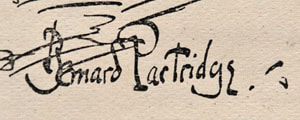
Sir Bernard Partridge RI NEAC (1861-1945)
Partridge was born in London and studied at the West London School of Art. His cartoons appeared in a variety of publications from the late 1880s and in addition to his black and white work, Partridge exhibited at the New English Art Club and with the Royal Institute of Painters in Watercolour. His first cartoons appeared in Punch in 1891 and he was made chief cartoonist in 1910.
‘Bernard Partridge was a new man with an outside reputation. He was brought to [Punch] by [F C] Burnand on the recommendation of Anstey and du Maurier, who admired his work as an illustrator… He believed a cartoon needed ‘a simple statement of theme, with a corresponding treatment making an instant and direct appeal to the reader; a sense of drama and of humour with powers of draughtsmanship and facility in portraiture, catching the essentials of a face in a few mocking lines.’… Partridge inherited from Tenniel the tradition that the principal cartoonist was a grand old man. He managed to become one quite young. His knighthood in 1925 was deserved and appropriate.’ (Price, 1957).
Collections
British Museum
Imperial War Museum
National Portrait Gallery
Victoria and Albert Museum
Sources and further reading
Bryant M and Heneage S (1994), Dictionary of British Cartoonists and Caricaturists 1730-1980, Scolar Press
Dolman B (1981), A Dictionary of British Artists, 1929, Antique Collectors’ Club
Johnson J and Greutzner A (1999), British Artists 1880-1940, Antique Collectors’ Club
Price R G G (1957), A History of Punch, Collins
Waters G M (1975), Dictionary of British Artists 1900-1950, Eastbourne Fine Art
Partridge was born in London and studied at the West London School of Art. His cartoons appeared in a variety of publications from the late 1880s and in addition to his black and white work, Partridge exhibited at the New English Art Club and with the Royal Institute of Painters in Watercolour. His first cartoons appeared in Punch in 1891 and he was made chief cartoonist in 1910.
‘Bernard Partridge was a new man with an outside reputation. He was brought to [Punch] by [F C] Burnand on the recommendation of Anstey and du Maurier, who admired his work as an illustrator… He believed a cartoon needed ‘a simple statement of theme, with a corresponding treatment making an instant and direct appeal to the reader; a sense of drama and of humour with powers of draughtsmanship and facility in portraiture, catching the essentials of a face in a few mocking lines.’… Partridge inherited from Tenniel the tradition that the principal cartoonist was a grand old man. He managed to become one quite young. His knighthood in 1925 was deserved and appropriate.’ (Price, 1957).
Collections
British Museum
Imperial War Museum
National Portrait Gallery
Victoria and Albert Museum
Sources and further reading
Bryant M and Heneage S (1994), Dictionary of British Cartoonists and Caricaturists 1730-1980, Scolar Press
Dolman B (1981), A Dictionary of British Artists, 1929, Antique Collectors’ Club
Johnson J and Greutzner A (1999), British Artists 1880-1940, Antique Collectors’ Club
Price R G G (1957), A History of Punch, Collins
Waters G M (1975), Dictionary of British Artists 1900-1950, Eastbourne Fine Art